Tonight, I returned to the Internet Archive. The last time I was there, I had promised that I would come back and play a game called Sex Olympics. I was not really being serious when I wrote that but, as I have learned over the past few days, when you promise your editor that you are going to review a game called Sex Olympics, she is not going to let you off the hook until you do it.
However, before playing Sex Olympics, I decided to run another scenario through President Elect (1987, Strategic Simulations, Inc.).

The last time I played President Elect, I simulated the current election and the game predicted that Donald Trump would win 535 electoral votes and 56% of the popular vote. (For the record, Hillary did win the District of Columbia.) This time, I decided to see what would have happened if, in 1980, the GOP had not selected Ronald Reagan and instead given their nomination to North Carolina Senator Jesse Helms.
According to the simulation, independent candidate John Anderson would have received a lot more votes than the 5 million he won in the actual election:


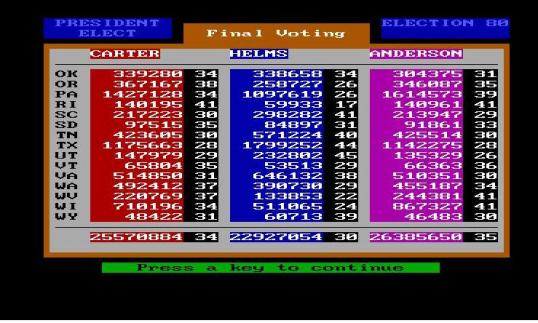
(For the record, in the actual election, Ronald Reagan won 50% of the popular vote, Jimmy Carter took 41% and John Anderson received 6.6%.)
But what would the electoral college look like?

In the simulation, John Anderson won the most electoral votes with 233. But it takes 270 electoral votes to win the election.
That’s not good.

There you have it! Jimmy Carter would have come in third but he still would have been elected President. Jesse Helms would have returned to the Senate and John Anderson would have been screwed over.
Once that was settled, I was ready to play Sex Olympics (1990, Free Spirit Software, Inc).

In Sex Olympics, you are legendary porn actor and intergalactic superstud Brad Stallion. You have been recruited to represent Earth in the Sex Olympics. Your goal is to go from planet to planet and do it with as many aliens as possible. But you have to be clever and you have to be quick because your main competition is Dr. Dildo and he appears to be much better at this than you are.
When the game starts, you are here:

You have a blond assistant named Sandie, who you can either ask questions or screw. Since Sandie never had much to say whenever I tried to talk to her, I went with screw.

Yeah, that’s hot.
Unfortunately, neither talking to nor screwing Sandie helped me with my main problem. I could not figure out how to get out of the damn room! I clicked on both doors. I clicked on the window. I pushed the “e” key for east and the “n” key for north. I tried to call someone on the phone. No matter what I did, the same thing happened:
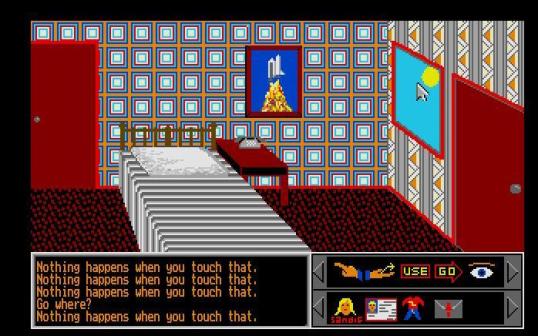
Finally, I figured out that you had to click use and then click a very specific place on the door on the west wall if you wanted to go outside. Clicking on go and then the door won’t work. Clicking on use and then clicking on door won’t work. No, you have to click on use and then click exactly on the door knob if you want to go outside.
I bet this crap never happens to Dr. Dildo.
Once I finally managed to get outside, I found the Big Thruster waiting for me.
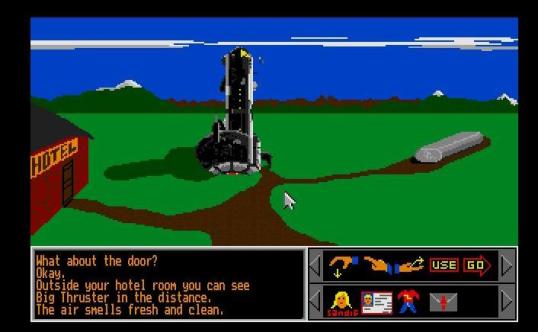
Inside Big Thruster, I discovered all the planets that I could go to in my effort to defeat Dr. Dildo and prove Earth’s carnal superiority:
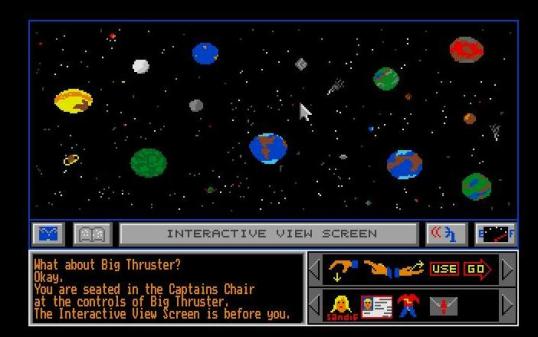
Let’s go to the big red one. Why not?
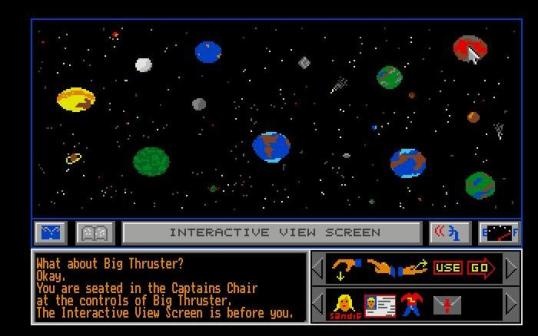
The big red planet turned out to be planet of volcanoes. This did not look promising but at least there was a village in the valley below.

I was heading into the village when suddenly…

That dog looks really mean! Forget this, I’ll just go back to Big Thruster and visit another planet!

This little white planet looks promising. Let’s see what it’s like.

Is that an igloo? Let’s see if anyone’s down there!

This is a lot better than that killer dog on the volcano planet! Let’s heat this igloo up!

“Inge has nothing to say.” That line pretty much sums up the entire game.

Oh, I have to manually tell the game that I want to remove my clothes? Sorry, I just assumed that it was implied.

Is it usually this difficult to have sex with a blue-skinned alien on an ice planet!?
Things got a lot more difficult when I was suddenly told that I had been arrested for indecent exposure and sent back to Earth!
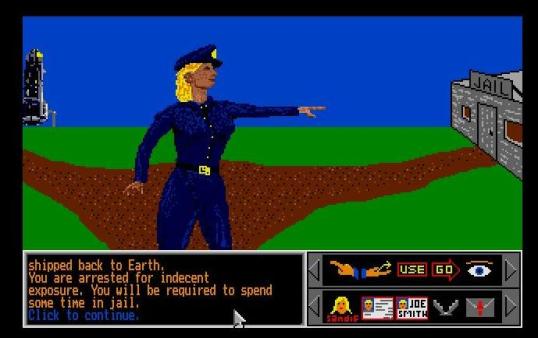
I don’t have time for this! I’m trying to defend the honor of Earth!

Good for Dr. Dildo.
Eventually, I was released from jail and I was sent back to where it all started.

And that’s when I said forget it. This is too much trouble for a planet that is not even willing to support me. Dr. Dildo can have the medal. Brad Stallion is retired!
After being left disappointed by Sex Olympics, I decided to try playing a game called Survival In New York City (Keypunch, 1986).

Survival in New York City is a text adventure game from Keypunch, a company that was notorious for stealing other people’s games and releasing them without any designer credits. That appears to be the case of Survival in New York City.
It’s still not a bad game. You wake up in an alley in New York City with no memory of who you are or how you got there.

Your goal is to not get killed while exploring New York. That is easier said than done.

A piece of advice: Don’t go near the teenagers until you have figured how to get a gun.
I played Survival In New York a few times. I got further every time but I still ended up dying. Sometimes, I was killed by teens. Sometimes, I was killed by Hell’s Angels. It is a game that I will be playing again.
After that grim journey through New York, I decided to finish off my visit by playing a classic, Lemonade Stand (1973, Minnesota Educational Computing Consortium).


Lemonade Stand was the very first business simulation game. You have a lemonade stand. Every day, you decide how much lemonade to make, how many signs to make, and how much to charge per glass. If you do a good job, you make money. If you do a bad job, you go out of business and have to live with the shame of failure for the rest of your life.
For some reason, I decided to open my lemonade stand on a cloudy day.

Because of the bad weather, I did not sell any lemonade on that day or the next. Finally, on the third day, I decided to take a chance and see what would happen if I tried to sell on a cloudy day. It was time to take a risk.

I know that some people would say, “With a 50% chance of rain, why even try?” I’ll tell you why. In this country, you gotta make the money first. Then when you get the money, you get the power. Then when you get the power, then you get the women.
Besides, what’s the worse that could happen?

At this point, I did what any gamer would do when the game was not going his way. I quit and started over.

Sunny! Now, this is more like it!

I took a chance. I invested all of my money in making lemonade. Unfortunately, that left me no money for advertising.

I ended up throwing out 70 glasses of lemonade but I still made a profit. That’s the important thing. Now, my fate and the fate of my lemonade business depended on tomorrow’s weather.

Oh yeah, baby! Hot and dry!

I had learned my lesson from yesterday. I made less glasses but I paid for two signs. And I charged a little more because it’s hot and dry. People are suffering out there. They need my lemonade and I need their money.

$4.15 in profit! I am a business genius! Get out of my way, Bill Gates! Look out, Warren Buffett! There’s a new player on the block!
But then I asked myself, “When did this crazy business become all about money?” It was supposed to be about the lemonade. I had made my money and proven my point. Taking my $4.15 with me, I pressed ESC and retired from the lemonade game.
I never looked back.
After that, I left the Internet Archive. I was through exploring for the night but I knew that I would come back in the future and simulate another presidential election or attempt to survive in New York City or maybe I would even get back in the lemonade business.
But you can forget about the Sex Olympics.
Dr. Dildo can have that medal.
























































